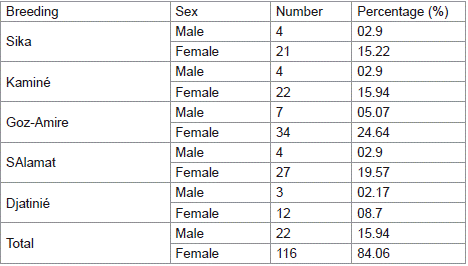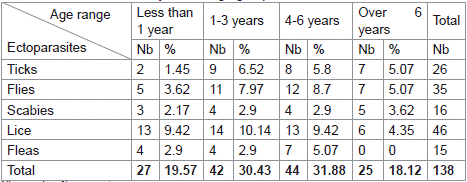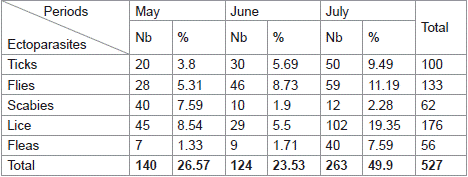
Research Article
Austin J Vet Sci & Anim Husb. 2025; 12(1): 1163.
Caprine Ectoparasites in the Urban Area of The City of Abéché, Eastern Chad
Ousmane Issa Abdel Djalil¹*, Mahamat Seid Souleyman², Vourchakbé Joël¹, Mahamat Issa Adoum² and Abdelsalam Adoum Doutoum³
¹Faculty of Exact and Applied Sciences, University of Moundou, PO Box 206, Moundou, Chad
²Department of Breeding Sciences and Techniques, Higher National Institute of Sciences and Techniques of Abéché, PO Box 130, Abéché, Chad
³Faculty of Science and Technology, Adam Barka University of Abéché, PO Box 1173, Abéché, Chad
*Corresponding author: Ousmane Issa Abdel Djalil, Faculty of Exact and Applied Science, University of Moundou, PO Box 206, Moundou, Chad Email: ousmaneissa_11@yahoo.com
Received: February 27, 2025; Accepted: March 17, 2025; Published: March 20, 2025;
Abstract
This study was initiated with the aim of studying goat ectoparasites in the urban area of the city of Abéché. It was carried out between May and July 2023 on thirty-two farms located in the districts of Sika, Kaminé, Goz-Amir, Salamat and Djatinié, representing a total of two hundred and fifty-nine goats. The main parameters studied were the infestation rates according to the sex and age group of the animals studied, the adult live weight of the goats and the monthly variation in the number of ectoparasites. The results showed that females were the most susceptible to ectoparasite infestation, with a prevalence of 84.06%, compared to 15.94% for males. Animals between 4 and 6 years of age were most infested (31.88%), followed by those between 1 and 3 years of age (30.43%), then those less than 1 year of age (19.57%), and finally those over 6 years of age (18.12%). The adult live weight of non-infested males was 35.20 kg compared to 34.76 kg for infested males. The adult live weight of non-infested females was 36.21 kg compared to 35.64 kg for infested females. The monthly variation in the number of ectoparasites reached a maximum in July (49.9%). These results show that females are most susceptible to ectoparasite infestation and that animals between 4 and 6 years of age are most infested.
Keywords: Ectoparasites; Goats; Infestation; Prevalence
Introduction
In the tropics, small ruminant breeding, particularly of goats, is one of the main socio-economic activities of rural households [3,7,16]. Moreover, indigenous goats are a genetic resource well adapted to diverse agro-ecological conditions and, together with sheep, represent the appropriate livestock species in areas unsuitable for agriculture and in places where other livestock species cannot be raised [11]. In a context of demographic explosion accompanied by high demand for food, especially of animal origin, small ruminants will play an important role due to their resilience, ease of maintenance in periurban or even urban areas, and short reproductive cycle [1].
Unfortunately, small ruminants are constantly exposed to a variety of bacterial, viral and parasitic diseases, not to mention almost permanent nutritional and water deficiencies, as well as adverse weather conditions (bush fires, floods, winds, dust, etc.). All of these factors are responsible for significant losses, which inevitably lead to high mortality, abortions, morbidity and stunted growth, as well as reduced production and reproduction [6].
Among these factors, parasites responsible for parasitosis are the most important contributors to losses. Many infectious diseases are transmitted from one animal to another by biting arthropods, which can become infected by taking a blood meal from an infected individual and transmit the pathogen to other individuals during subsequent meals [4,13]. Furthermore, the lack of information on ectoparasites, including their etiology, modes of transmission, vectors, treatment, etc., has implications for animal health and economic profitability [6].
This study was initiated to investigate caprine ectoparasites in the urban area of the city of Abéché.
Methodology
Study Area
The study was carried out between May and July 2023 in the urban area of the city of Abéché, located in north-eastern Chad between the 11th and 16th parallels north and the 20th and 23th parallels east, it covers an area of 30 km2.
The climate is Sahelian, with alternating dry and rainy seasons. The average temperature is 32.8 °C, with extremes of 40.2 °C and 24.9 °C respectively for the hottest (May) and coldest (January) months of the year [7]. The rainy season lasts around two to three months, from July to September, with an annual rainfall of 441.3 mm.
Materials
Animal Material
Two hundred and fifty-nine Sahelian goats from 32 goat farms in 5 districts (Sika, Kaminé, Goz-Amir, Salamat and Djatinié) in the urban area of Abéché were studied.
Age Determination of Goats
The age of the goats was determined by counting the number of pairs of incisors, taking into account the declarations of the breeders.
Collection and Preservation of Ectoparasites
The following methods were used to search for and collect ectoparasites on the goat:
- Direct visual inspection of the different body parts of the goat;
- Each goat was examined for a minimum of 5 minutes;
- Ectoparasites were collected directly from the goats’ bodies and stored in hermetically sealed tubes containing ethanol at 70°;
- The tubes were labeled with the following information: sample serial number, study site, date of collection, sex, host age, and site of collection on the host;
- The samples were then sent to the parasitology laboratory of the Higher National Institute of Sciences and Techniques of Abéché for identification.
Identification of Ectoparasites
Identification is made using the identification keys of Walker et al [17] and Perez-Eid [14], based on the observation of morphological characteristics. Handling is done in a Petri dish with forceps and under a magnifying glass.
Prevalence (P)
This is the ratio between the number of individuals of a host species infested by a parasite species and the total number of hosts examined, expressed as a percentage.
Statistical Analysis
The collected data were analyzed using XTSTAT software (2016.02.28451). Descriptive analysis was used to determine dispersion parameters (mean, standard deviation and frequency), and analysis of variance (ANOVA 1) was used to compare means ± standard deviation. The Chi2 test was used to compare means. The significance level was set at 5%.
Results
Infestation Rates by Sex of the Animals
The variation in ectoparasite infestation rates according to the sex of the animals is summarized in Table 1. According to the results obtained, we found that the infestation rate is much higher in females (84.06%) than in males (15.94%). These results may vary from one farm to another.

Table 1: Infestation rates by sex of animals examined.
Infestation Rate by Age Group of Animals
Table 2 shows the distribution of ectoparasites according to the age of the animals.

Table 2: Infestation rates by animal age group.
The most infested age group is 4-6 years with an infestation rate of 31.88%, followed by 1-3 years with an infestation rate of 30.43%. The least infested age groups are under 1 year and over 6 years, with infestation rates of 19.57% and 18.12%, respectively.
Effect of Ectoparasites on the Weight Performance of Goats
Table 3, which summarizes the weight performance of goats, shows that the live weights of adult males, adult females, farrowing weights and weaning weights of non-infested animals were 35.20 kg vs. 34.76 kg), (36.21 kg vs. 35.64 kg), (2.0 kg vs. 1.55 kg) and (17.33 kg vs. 16.5), respectively, which were significantly (p<0.05) higher than those of infested animals.

Table 3: Weight performance of goats.

Table 4: Monthly variation in the number of ectoparasites.
Monthly Variation in the Number of Ectoparasites
Among the five hundred and twenty-seven (527) individuals for which ectoparasites were collected during the three months of the study, the number of lice (19.35%), flies (11.19%) and ticks (9.49%) was highest in July compared to the other species and the other months. On the other hand, fleas were lowest in May (1.33%) and June (1.71%), and scabies in June (1.9%). On the other hand, the increase of these ectoparasites was observed in July with a percentage of 49.9%, followed by May (26.57%) and June (23.53%).
Discussion
Infestation Rates by Sex of Animals Examined
According to the results obtained, we found that the rate of ectoparasite infestation was higher in females than in males, with a prevalence of 84.06% in females against only 15.94% in males. Our results are similar to those of (Naama and Boukerche, 2020) in the Djelfa region of Algeria, who reported higher ectoparasite infestations in females, with prevalences of 82% versus 18% in males. In contrast, (Dawit et al., 2012) reported prevalences of 51.9% in females and 45.9% in males among goats in northwestern Ethiopia. Furthermore, several studies on ectoparasites in goats have shown that females are more infested than males [10,12].
According to (Rony et al., 2010) and (Orji et al., 2012), this variability can be explained by additional reproductive and milk production demands, as well as certain hormonal variations such as gestation and lactation stressors that weaken the immune system of females. (Orji et al., 2012) and (Obi et al., 2014) claim that males are generally less infested than females due to their activities, which help to passively reduce ectoparasites. They could also transmit these parasites to healthy females during mating.
Infestation Rates by Animal Age
In this study, the prevalence of ectoparasite infestation was 31.88% in animals between 4 and 6 years of age, 30.55% in animals between 1 and 3 years of age, 19.92% in animals under 1 year of age, and 17.84% in animals over 6 years of age. These results are comparable to those obtained by (Noor et al., 2016), who found that goats aged under 6 months were the most infested with ectoparasites, with a prevalence of 55%, compared to 26.67% in goats aged over 6 years.
Studies on ectoparasites by (Kaddi et al., 2020) show prevalences of 51.35% for ticks in adult goats and 32.35% in young goats. Adult goats also have a higher prevalence of lice infestation (63.8%) than young goats (36.2%). In goats, ectoparasite prevalence was highest in animals between 1 and 5 years of age, with a rate of 54.0% [10].
Effect of Ectoparasites on Goat Weight Performance
Goat weight performance showed that live weights of adult males, adult females, farrowing weights and weaning weights in non-infested animals were 35.20 kg, 36.21 kg, 2.0 kg and 17.33 kg, respectively. These values were significantly (p<0.05) higher than those recorded in infested animals. Considering the results obtained, we can see that parasitized goats were much more exposed to various problems (decrease in production and reproduction, decrease in body weight, etc.), whereas non-parasitized animals showed a significant increase in body weight.
Monthly Variation in the Number of Ectoparasites
Of the five hundred and twenty-seven (527) ectoparasites collected during the three months of the study, the number of lice (19.35%), flies (11.19%) and ticks (9.49%) was highest in July compared to the other species and months. On the other hand, the number of fleas in May (1.33%) and June (1.71%) and the number of mange mites in June (1.9%) were the lowest. On the other hand, the increase of these ectoparasites was observed in July with a percentage of 49.9%, followed by May with a percentage of 26.57% and finally June with a percentage of 23.53%.
Conclusion
The study of ectoparasites in goats in the city of Abéché showed that females are more susceptible to infestation by these parasites than males. Animals between 4 and 6 years of age were the most infested, while those over 6 years of age were the least infested. The adult live weight of uninfested males was 35.20 kg, compared to 34.76 kg for infested males. The adult live weight of uninfested females was 36.21 kg compared to 35.64 kg for infested females. Finally, ectoparasites reached their highest levels in July.
References
- Bouchel D, Koussou MO. Rôle de petits ruminants dans l’approvisionnement des villes en produits animaux et d’origine animale. Projet régional de recherche sur les Petits Ruminants, synthèse scientifique. 1998: 51-64.
- Dawit T, Mulugeta A, Tilaye D, Mengistie T. Ectoparasites of small ruminants presented at Bahir Dar Veterinary Clinic, Northwest Ethiopia. African. J. Agric. Resseach. 2012; 7: 4669- 4674.
- Guingouain C. L’élevage des petits ruminants en milieu paysan dans les régions de la Kara et des Savanes au Togo: Diagnostic technicoéconomique. Thèse de Doctorat Vétérinaire, école nationale vétérinaire, Maisons-Alfort. 2017; 209.
- Hunter A. La santé animale : principale maladie. Vol 2.Ed. Karthala. France. 2006; 303.
- Kaddi N, Kerakria H, Nour Imene SH. Les ectoparasitoses chez les caprins. Mémoire de Master. Université Ibn Khaldoun-Tiaret. 2020; 58-60.
- Mahamat IA. Impact des ectoparasites sur quelques performances zootechniques chez la chèvre sahélienne dans la zone urbaine de la ville d’Abéché. Mémoire de Master. Institut National Superieur des Sciences et Techniques d’Abéché, 2023; 1-2.
- Mbaidingatoloum FM. Paramètres de reproduction et application de l’insémination artificielle pour l’amélioration de la productivité chez la chèvre sahélienne au Tchad. Thèse de Doctorat Unique. Université de Bobo Dioulasso. 2011: 146.
- Naama R, Boukerche H. Contribution à l’étude des ectoparasites des caprins dans différentes localités dans la région de Djelfa. Mémoire de Master. Université de Djelfa. 2020: 56.
- Noor J, Ahaduzzaman M, Hossain MMA, Hossain MA, Sarker MS, Rahim SA. Prevalence and morphological identification of tick species infestation in goat in Chittagong, Bangladesh. Veterinary Sciences: Research and Reviews. 2016; 2: 42-46.
- Obi Zita C, Anyaegbunam Lucy, Orji MaryKate N. Ectoparasitosis, a challenge in sheep and goat production in ULI, Anambra state, Nigeria. ISSN 2347- 2677; IJFBS. 2014; 1: 27-29. 59.
- Onzima RB, Gizaw S, Kugonza DR, Van Arendonk JA, Kanis E. Production system and particpatory identificaton of breeding objective traits for indigenous goat breeds of Uganda. Small Ruminant Res. 2018; 163: 51-59.
- Orji NM, Onyechi AA, Obiorah SC, Ezeagwuna DA, Ezeigbo EU. A Survey of the Ectoparasites and Grazing Habits of Goats in Uli Town, Ihiala L.G.A Anambra State. 2012; 49: 31.
- Ousmane Issa AD, Abdelsalam Adoum D, Mahamat Seid S, Mahamat Issa A. Infestation of Ectoparasites in Sahelian Goats in the Urban Area of Abéché Chad. J Vet Med Animal Sci. 2024; 7: 1147.
- Perez-Eid C. Les tiques (Identification, biologie, importance médicale et vétérinaire. Revue Monographi de Microbiologie. 2009; 316.
- Rony A, Mondal MMH, Islam MA, Begum N. Prevalence of Ectoparasites in Goat at Gazipur in Bangladesh. Int. J. BioRes. 2010; 2: 19-24.
- Tchouamo IR, Tchoumboué J, Lise T. Caractéristiques socio-économiques et techniques de l’élevage des petits ruminants dans la province de l’Ouest du Cameroun. Tropicultura. 2005; 23: 201-211.
- Walker AR. Ticks of domestic animals in Africa: à guide to identification of species. Univ. Edinburg. Ed: ICTTD. 2003; 221.